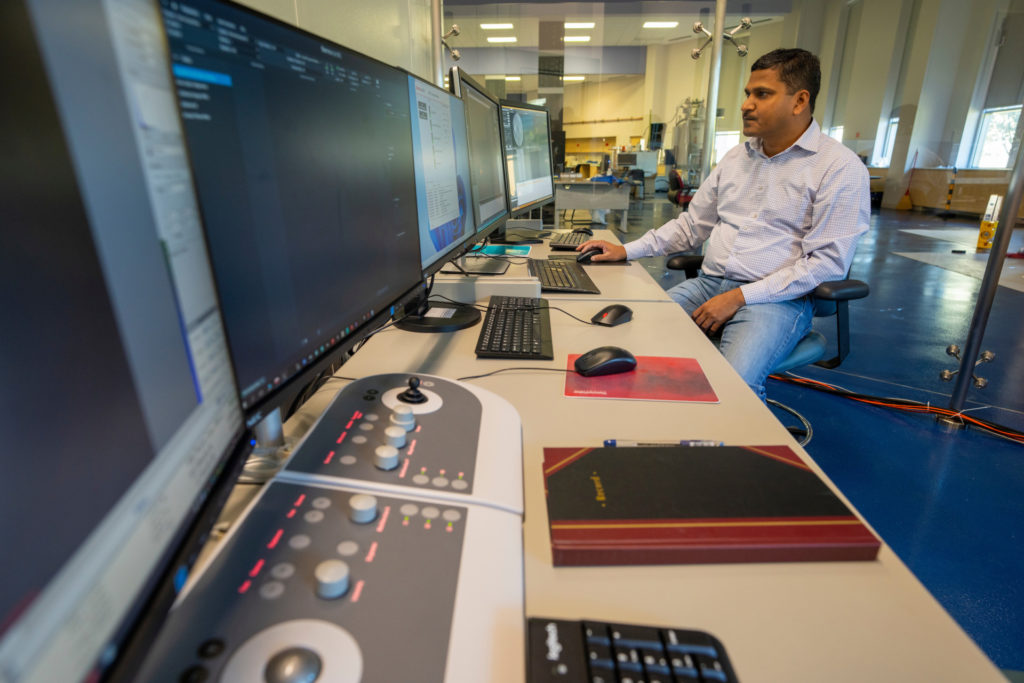Atomic-resolution microscopy facility opens at Texas A&M
Grand opening and symposium set for Saturday, Dec. 3
A state-of-the-art resource for cryogenic-electron microscopy, cryo-EM, is now set up at the Texas A&M College of Agriculture and Life Sciences Department of Biochemistry and Biophysics and open to all academic and industry users.

The new instrumentation will greatly improve researchers’ ability to image large and small molecules on the Texas A&M University campus. That equipment includes a Thermo-Fisher Krios G4 as well as specialized tools for sample preparation.
“Our department houses the first high-end cryo-EM facility within The Texas A&M University System, and we have the newest, highest-resolution model of the instrument,” said Josh Wand, Ph.D., distinguished professor and head, Department of Biochemistry and Biophysics. “We expect this resource to catalyze many local research projects in structural biology, chemistry, engineering or other fields.”
To unveil the resource and show how faculty, staff, students and industry researchers can utilize it, the Department of Biochemistry and Biophysics has organized a free, full-day symposium on Saturday, Dec. 3 in the Biochemistry and Biophysics Building in College Station.
Spaces are limited, with only a few spots remaining. Register at tx.ag/CryoEM.
“This leading-edge instrumentation can advance research and enhance teaching in many fields, and I’m excited to see the Texas A&M System community make use of it,” said Jeffrey W. Savell, Ph.D., vice chancellor and dean for Agriculture and Life Sciences.
All the things you need for cryo-EM

Cryo-EM technology in the past several years has advanced to the point where it can be used to discern the location of each atom in a large molecule such as a protein.
The new facility at Texas A&M offers state-of-the-art equipment for:
- Single-particle cryo-EM.
- Cryo-electron tomography.
- Microcrystal electron diffraction.
- Versatile, specialized imaging.
- Specimen preparation for obtaining the highest quality images.
The carefully renovated space for the instruments in the Biochemistry and Biophysics Building is among the most serene locations on campus. The enclosure was built to minimize vibration, electromagnetic field interference, and changes in temperature, humidity and airflow, according to Junjie Zhang, Ph.D., associate professor and cryo-EM faculty director in the department.
“Before the instruments were installed, you could hear a needle drop, it was so quiet,” Zhang said. “This type of room was originally designed for musicians. We also make sure electromagnetic fields are being shielded to make sure there is no interference from the nearby instruments in the building.”
The team also plans to expand the facility’s capability over the next few years.
“This is a good starting point for Texas A&M to integrate this capability, but it’s not the end point,” Zhang said.
Other benefits of the local setup
In addition to the advanced equipment, the resource is staffed with experts such as Gaya Yadav, Ph.D., cryo-EM technical director. The department also plans to hire additional faculty members who specialize in cryo-EM, including Xuewu Sui, Ph.D., who will take a position as assistant professor at the department in January.
Zhang’s research program often employs cryo-EM. For the team’s recent work on the bacterium that causes tuberculosis, the samples needed to be sent to an off-site center. Now, having the instruments on campus offers a huge boost in speed and convenience, Zhang said.
“If you ship to other research facilities, there is a long wait time. Here, at least at the beginning, there are not too many users, and you can get immediate feedback,” Zhang said. “And also, here is Dr. Gaya Yadav who we can talk to about any troubleshooting. Researchers in my lab can quickly adjust the specimen based on feedback from the cryo-EM center.”
How to work with the cryo-EM resource
Yadav is the first point of contact for those interested in working with the facility.

He is a cryo-EM expert who has participated in and overseen many molecular biophysics and cellular physiology projects that employed the technique. Before his current position, he served as the cryo-EM center manager at the Hauptman-Woodward Medical Institute in Buffalo, New York.
Yadav earned bachelor’s degrees in botany and chemistry and a master’s in chemistry from the University of Lucknow, India. In 2011, he earned his doctorate in biochemistry and structural biology at Jawaharlal Nehru University in New Delhi, India. He later pursued postdoctoral work at the University of Texas Southwestern Medical Center in Dallas and at the University of Florida, Gainesville.
“The facility is operational, available to everyone at Texas A&M and open for reservations,” Yadav said.
Those interested in obtaining training or using the facility should contact Yadav at [email protected].


